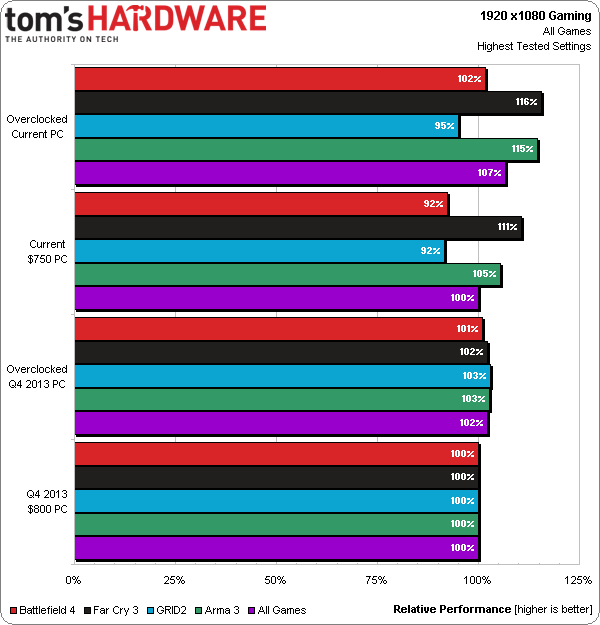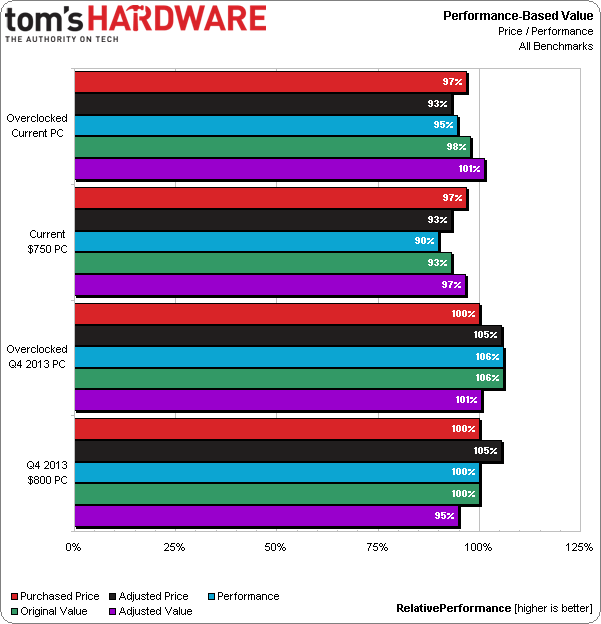System Builder Marathon, Q1 2014: The $750 Gaming PC
Did I Achieve My Goals, Or Is This A Failure?
This quarter, I set out to build a more affordable gaming equivalent to my previous $800 PC, which, in three months, rose in cost by an astounding $137. Unfortunately for me in this piece, but good for gamers as a community, Radeon R9 280X prices aren't as bad as they were a month ago. It'd be great to see them back down at $300, though the cheapest models as of this writing sell for $350 on Newegg.
We recently introduced some new tests to the System Builder Marathon benchmark suite, and those were the current build's target apps. In them, my current effort serves up 90% of the $800 machine’s average frame rates. That number jumps to 94% once its GeForce GTX 770 is overclocked. Interestingly, I get the same exact totals for stock and overclocked performance in our previously-tested games. Of the titles we used to run, only Far Cry 3 carries over.
But my comparison doesn't end there. In fact, I need a few more charts to keep telling this story. The games we just added are unquestionably less processor-bound. As a result, sporting similarly-quick graphics hardware, the new $750 system competes readily at the most interesting resolutions against my old build, going so far as to beat it once I overclock them both.
The gains seen at high resolutions help this quarter's PC pick up a few percentage points of overall performance, too.
Spending more on the case, power supply, memory, and graphics card prevents the Q1 2014 build from matching the as-purchased value of my $800 machine. However, when I adjust both systems to reflect today's pricing and isolate the performance-oriented parts, my $750 box scores a victory in its stock form. Here's the thing, though: once I overclock the Core i5 in last quarter's machine, value evens out again.
If all you care about is gaming at 1920x1080 or higher, today's cheaper PC is just as capable as the last one I built for more money. Your only concern should be running out of graphics memory at Surround resolutions, which might not be playable anyway, depending on the settings you're using.
Of course, the averages don't give us the whole story, so we turn to the individual games. My $750 machine leads in Far Cry 3, Battlefield 3, and Arma 3, while the $800 PC scores big in Grid 2, F1 2012, and The Elder Scrolls V: Skyrim. Both rigs trade blows in Battlefield 4, which either favors the Core i5 processor or Radeon R9 280X more than its predecessor. In a blind test, I'm willing to bet that you couldn't tell the difference, though.
The good news for me is that, despite lofty prices on some components, this most recent machine is a success. The competition is a fundamental tie, and I'd need to test more games to try pinpointing a winner. Intel’s Core i3-4130 again proves itself to be a capable value-oriented gaming processor able to keep up with Nvidia's GeForce GTX 770 in the seven titles we tested. At the same time, I don't have anything bad to say about the previous gaming builds either. As prices drop, AMD’s Radeon R9 280X re-joins the GeForce GTX 760, Core i5-3470, and FX-6300 as worthy options for your next gaming PC.
Current page: Did I Achieve My Goals, Or Is This A Failure?
Prev Page Summarizing The Performance Of Three Gaming BuildsGet Tom's Hardware's best news and in-depth reviews, straight to your inbox.
-
blackmagnum This is the everyday Joe sort of gaming PC... cheap and workable. Why not Core i5 quad-core?Reply -
hmp_goose "The games we just added are unquestionably less processor-bound." This sounds like a major oversight, I fear …Reply -
ingtar33 nice build, and a good example of how even modern multi-threaded games are STILL at their heart primarily single or dual threaded games. We see this in BF4 most clearly, as the advantage of MOAR CORZ vanishes once you pass the 3rd core on the cpu... meaning a dual cored and hyperthreaded intel is still a viable gaming option; and though you can get an fx8320 for the same price as that i3, almost nothing truely makes use of 8 cores yet. I say yet, because the next gen game consoles will force games to become truly multithreaded in the future. Purhaps down the road the old piledriver chips will start to look like a great gaming value, but the situation today is still largely the same problem facing AMD 3 years ago... which is games simply don't really need MOAR CORZ. Not really anyway. I'm sure some people will have issues with using an i3, but really i think it was a fantastic read; and quite informative. Its important we keep things in perspective... and as things stand now you really don't need much more cpu power then a dual cored pentium or i3... or i guess quad core phenomII or piledriver fx.it all comes down to what you can afford to build around it.Reply -
lostgamer_03 The i3 was a bad choice, why not get an i5-3330 which is about the same in price and it offers 2 more fully enabled cores, which really would help in applications and the 'newer' games.The MOBO would also be cheaper as it is last gen.Reply -
de5_Roy the psu was a smart choice for the case, imo. modular cabling prevented the usual clutter seen in cases like these. the resulted unusually clean look of the inside. 80+ gold efficiency is also welcome. i don't think clean cable management can be measured in charts, but it's an added bonus.Reply -
pauldh That's what I thought too de5_Roy. Modular and 80 PLUS Gold was well worth spending an extra $15.Reply -
bemused_fred ReplyThe i3 was a bad choice, why not get an i5-3330 which is about the same in price and it offers 2 more fully enabled cores, which really would help in applications and the 'newer' games.The MOBO would also be cheaper as it is last gen.
When I first saw the parts list for this build, I expected myself to be in full agreement with you. I mean, can you imagine someone suggesting paring a GTX 680 with an I3? Ludicrous. They'd be laughed out the forums. However, looking at the benchmarks for the highest settings in 1920x1080 and 4800x900, I found there were 2 types of results
1. Those where the I3 and the GTX 770 build beat, or were within a few FPS of the I5 and R9-280X build:
Battlefield 3
Battlefield 4
Arma 3
Far Cry 3
2. Those where the I5 and R9-280X beat the I3 and GTX 770 build by a significant margin, but where all frame rates were well above 60FPS:
F1 2012
Grid 2
Skyrim
So, while overall performance percentage charts might put the I3 and GTX 770 behind the I5 and R9-280X behind in certain games, in a real-life setting, it seems that the I3 and GTX 770 is an equally good build. Which is really not what I was expecting.nalmost nothing truely makes use of 8 cores yet. I say yet, because the next gen game consoles will force games to become truly multithreaded in the future.
Citations desperately needed. The XBOX 360 had 3 hyper-threaded CPUs and the PS3 had a 7-core cell CPU, but this didn't push PC games during this period beyond dual cores. Indeed, as late as January 2012, Tom's hardware was finding it impossible to recommend any Quad-core AMD processors over intel Dual-core processors and as late as December 2012, dual-core Intel pentiums were taking the low-end recommendations, as they were still better at gaming at this point than 4-core AMD processors. Indeed, it wasn't until February 2013 that they reversed this recommendation, so any assumption that consoles having more cores will result in P.C. games using more cores doesn't really stand up to scrutiny, I'm afraid. -
pauldh ReplyThe i3 was a bad choice, why not get an i5-3330 which is about the same in price and it offers 2 more fully enabled cores, which really would help in applications and the 'newer' games.The MOBO would also be cheaper as it is last gen.
As explained on page 1, the whole idea here with this build was to spend less on the platform, more-than covering the premiums on graphics, RAM, and ODD vs. our last purchase.
Sure we'd go i5 if priced the same. But the -3330 is $60 more @ $190, just like the -3470 used last quarter. The -3350P saves $10 off that. H61 doesn't save much, starting $5-10 below H81, and then we'd give up capitalizing on the i5's limited overclocking. -
pauldh @bemused_fred - Yes, exactly! Good post.Reply
I was surprised to see i3 didn't yield any meaningful drop in minimum fps, at all! In fact, minimums often appeared GPU-bound, and the new GTX 770 rig won out, especially OC'ed. System bound at 70+ fps and up full-time in Skyrim or F1 2012 is hardly a loss, but an extra 3-8 fps consistently down low in ARMA III and Far Cry 3 could come in handy.
-
redgarl CPU choice is really overated with a single graphic card. The conclusion proves it. I would even stretch to go AMD to cut some money to fetch up two 750ti-760 GTX or 2 R7 graphic card.CF or SLI of two low tier graphic cards provide really good performances for a budget.Reply





